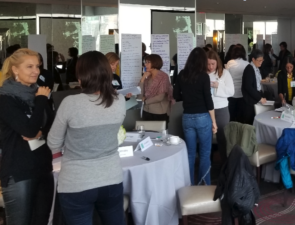Many people pick up a copy of Designing Your Life looking to make a significant change in their personal or professional life. And while the book provides a guide to designing your life, it can be difficult to hold yourself accountable through the process.
Change is hard. There are no shortcuts. It takes time, effort and resiliency to focus and test new prototypes – especially considering that your life design may be constantly evolving.
As you journey to make long-term, sustainable change you may hit a wall or face a few stumbling blocks along the way. Using the S.C.I.E.N.C.E. of Change, a framework developed by Sean Young, you can tackle the obstacles that get in your way and make change easier.
Use this simple approach to create lasting change in your life:
(S)tepLadders: Knowing something is beneficial for you doesn’t always translate into action. Create small prototypes to propel yourself forward into change and build momentum. Take small steps to test your prototype to reduce feelings of failure and increase feelings of progress.
(C)ommunity: Actively pursue a life design team to help you accomplish your goals. Surround yourself with people who support you, offer accountability, and can model good behavior. Without someone to hold you accountable or provide positive reinforcement, it becomes much harder to succeed. Check out the Designing Your Life Workshops if you’re interested in joining a community with a common purpose.
(I)mportant Priority: The change that you want to make in your life must be important to you. It should more important than your other priorities because it needs to displace them. You can’t create change if your new habit isn’t important enough for you to prioritize over other to-dos. Reflect on what you aim to accomplish – is it really a priority for you?
(E)asy: The change you want must be easy and accessible to you, or you may give up before even starting. Make sure the change you aim for requires resources that are accessible to you.
(N)eurohack: You may initially feel motivated and invigorated after reading the book or participating in a workshop but returning to a familiar environment and losing momentum can cause you to fall back into your old routines. Changing your habits is the easiest way to make a lasting change. Change your mind’s pathways by setting up creative ways to remind yourself of your new behavior.
(C)aptivating Rewards: Don’t fret about setbacks and abandon your goals after missing a milestone or faltering on your new routine. Celebrate wins, big or small, with small rewards, like a new pair of sunglasses or a nice dinner. Not only does it make you feel good about what you’re doing but it reinforces the behavior on a neurological level.
(E)ngrained: Pair your new behavior with an existing habit to make it easier to engrain into your daily life. This will help you build off habits, instead of trying to create a habit from scratch. Remember, it takes time to change your old habits. Most of us are impatient to see results, but they will come if you are consistent and resilient.
Change is difficult, but designing your journey using the S.C.I.E.N.C.E. of change will greatly increase your odds of success. Read more on the science of change in Sean Yong’s 2017 book, Stick With It: A Scientific Process for Changing Your Life for Good.










